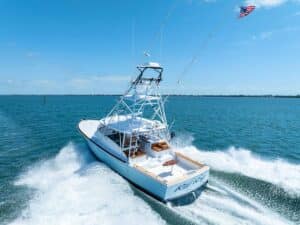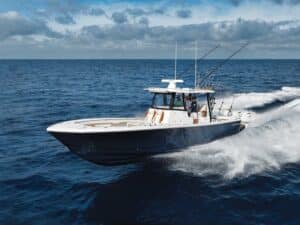
choosing a tender
Over the last 20 years, the size of sport-fishing boats has increased tremendously.
Back in the late ’70s and early ’80s, 55- and 60-footers were considered huge for sport fishing, and many top captains said that they were just too big. But as these boats’ size increased, so did their range — opening up incredible opportunities in remote areas with fish-rich waters.
These larger boats also allowed the owner to do things besides fishing offshore — especially during periods of rough weather or when the big-game fishing turned slow. The extra length allowed owners to mount a flats skiff, or tender, up on the bow, and these little boats bring a whole new dimension to any extended trip.
When we travel on Brier Patch with a skiff, we eventually start providing what we call our “tropical tours” — to allow our guests to do some extra fishing and exploring. Anything, from checking out the nooks and crannies of an island, catching live bait, snorkeling, fishing the flats or fluke-fishing a coastal bay, or any other kind of light-tackle inshore fishing, is readily accessible for a skiff or small tender. Choosing the right tender — one that will offer more fishing and diving opportunities, is easy to get in and out of, and doesn’t overtake the bow with its presence — is a great tool for the traveling sport-fishing operation.
When I researched putting a skiff on the bow of the 58-foot Brier Patch back in 2002, I knew we needed something functional to expand our fishing opportunities, but it also had to look right on the bow of our beautiful custom boat. The tender needed to be practical, so we could easily ferry guests in and out of the port when anchored out; it had to be able to hold and carry bait back to the big boat; and, most importantly, it had to be lightweight so that it did not affect Brier Patch’s performance in any significant way.
The good news is that advanced, composite lightweight construction techniques became readily available in many skiff applications as shallow-water guides and anglers kept pushing builders to reduce weight and create better “technical” poling skiffs to reach deeper into the super-skinny waters of the backcountry. Since most of these flats skiffs range in size from 14 to 20 feet, they make the perfect boat for a bow loading application on a wide range of game boats.
The first company to really push the envelope and create a product that accomplished those goals was Hell’s Bay Boatworks, with its 16-foot Whipray, developed by company founders Flip Pallot, Hal Chittum and Chris Morejohn. That model, and others that followed, forced other skiff builders to create models that were lighter, carried less horsepower and got into shallower water. Under the leadership of owner Chris Petersen, Hell’s Bay still builds some of the finest, high-quality technical skiffs on the market today.
Another early leader in the shallow-water skiff market, Scott Deal’s Maverick Boat Company (which also builds Hewes flats boats) also offered lightweight technical skiffs built with advanced construction practices — such as its infusion process that precisely and evenly meters out the perfect amount of resin into the fabric.
Nowadays, you can find a plethora of skiff builders out there that offer great options for a traveling rig that not only looks the part, but also offers a great diversion when those fishing opportunities present themselves.
You need to consider several key factors when choosing the right rig for your bow. First, you need to know what will fit. And that doesn’t mean just measuring the length of the skiff and popping it on. You also have to consider your crew’s ability to move around on the foredeck to launch and load the skiff, access the anchor and windlass, and work the lines when docking.
Secondly, you must know what capacity davit your boat can handle. Will it be electric with self-contained hydraulics and motor, or will it have a remote mounted motor and hydraulics? Typically, any davit with a lifting capacity over 1,200 pounds requires a remote mounted motor and electronics. The “wet” weight of your skiff determines the size of the davit you require.
You must also sort out how and where to mount the chocks that the skiff rests on. Make sure the foredeck can handle the weight, and always use through-bolts and a backing plate to mount your chocks. You may have to remove a headliner down below to install the backing plates, but relying on screws to fasten the mounting chocks is just asking for trouble. In rough weather, it’s not uncommon to take some green water over the bow — with our through-bolt installation, we’ve never seen our skiff move.
We recently upgraded to a 72-foot Merritt, and I couldn’t bring myself to put a bulky, high-sided, awkward-looking rubber boat up on the bow. Rubber ducks have their place as tenders, somewhere, but not for a serious sport-fishing/diving operation. First of all, they are kind of hard to get in and out of in general, but especially when diving, and they can’t be fished practically, since they have limited space inside with little or no storage, deck space, rod holders or livewells. So we just took our little flats skiff right along with us when we switched to the bigger boat.
We’ve used a 17.8 Professional, built by Hell’s Bay, coupled with a 60 four-stroke Mercury. We’ve taken this little skiff everywhere, and it fits our criteria beautifully. Hell’s Bay offers several models that vary as to weight, horsepower and livewell options, and all make practical options for a tender. They also have the ability to customize the skiff to your specific needs.
Maverick Boat Company builds several models from 16 to 20 feet that work as fine tenders as well. With a myriad of power, livewell and console configurations, they also have the ability to match any skiff to your application.
The new kids in this arena both offer high-tech solutions that are not only practical but are cutting edge in their design, materials and building processes. Mark Castlow’s Dragonfly Boatworks builds techy, vacuum-infused 16- and 17-footers. And once again, Hal Chittum pushes the envelope with his new Islamorada 18 Chittum Skiff that is a blended-fabric, post-cured, epoxy pre-preg skiff that is super light and super tough.
No matter what make or style of tender you choose, the decision to bring along a secondary skiff opens up a whole new world of fun and alternative fishing opportunities to explore during your travels.
**
Skiff Manufacturers**
www.dragonflyboatworksllc.com
www.chittumskiffs.com
www.maverickboats.com
www.hellsbayboatworks.com







